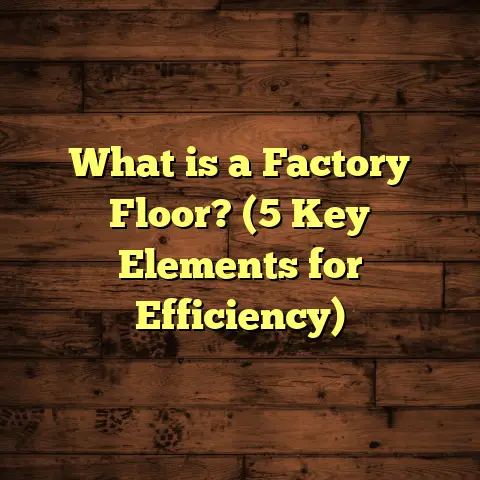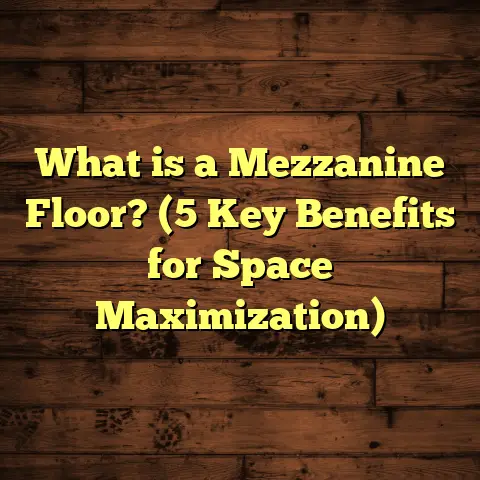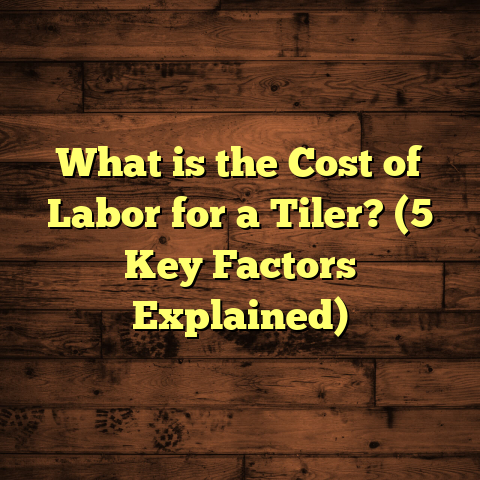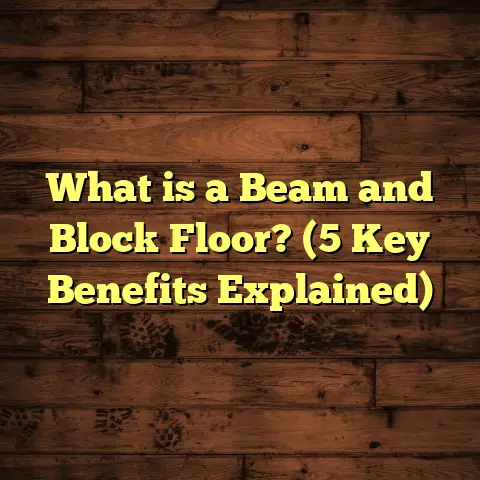What is Floor A on a Property Card? (5 Key Insights Revealed!)
Have you ever found yourself staring at a property card, wondering what “Floor A” means? Maybe you’re buying a home, renovating, or just curious, and you’ve come across this term but aren’t quite sure what it entails. I’ve been working with homeowners, contractors, and real estate agents for years, and understanding Floor A is more important than many realize. Let me share with you everything I’ve learned about this often-misunderstood term.
What Is Floor A on a Property Card?
At its core, Floor A refers to the main finished living area of a property as recorded for tax assessment or real estate purposes. It’s essentially the square footage of the heated and finished space inside your home where people live and spend most of their time. This figure is what local tax assessors, appraisers, and sometimes insurance companies use to determine property value, tax rates, and insurance premiums.
For example, if you own a house in Phoenix, Arizona, and your property card says Floor A is 1,800 square feet, that means the assessor has recorded 1,800 square feet of finished living space that’s heated and cooled. This number excludes unfinished basements, garages, or sheds.
I remember working with a family in Denver who was confused why their property card showed only 1,250 square feet for Floor A when their home felt much bigger. After digging into the details, we discovered the assessor hadn’t included their finished basement or a converted attic space because those areas didn’t meet specific local criteria. That’s a perfect example of how Floor A can vary depending on local rules.
Why Is Floor A Important?
Knowing what Floor A means can help you understand:
- How your property taxes are calculated
- How appraisers value your home
- What insurance companies consider insurable space
- How to plan renovations or expansions intelligently
Your Floor A measurement isn’t just a number; it directly affects your wallet and your home’s marketability.
The Five Key Insights About Floor A
I want to give you five key insights that I’ve gathered over the years that will help you make sense of Floor A and its implications.
Insight 1: Floor A Includes Only Finished and Heated Areas
Floor A doesn’t count every square foot inside your property boundaries. It’s limited to spaces that meet specific criteria—mainly, finished living spaces that have permanent heating or cooling systems.
This means:
- Bedrooms, bathrooms, kitchens, living rooms usually count.
- Enclosed sunrooms that are heated/cooled count.
- Finished attics with proper insulation and HVAC count.
- Unfinished basements usually don’t count unless they’re fully finished with heating/cooling.
- Garages almost never count unless converted into living spaces.
- Porches, patios, decks usually don’t count unless enclosed and conditioned.
A good example from my personal experience: I installed new hardwood floors in a client’s 1,600 sq ft Floor A space in Austin. Their attached garage was 400 sq ft but wasn’t conditioned or finished; the garage area wasn’t included in Floor A. When they later converted part of the garage into a heated workshop with drywall, HVAC, and flooring, the property card was updated to add that space to Floor A.
Insight 2: Local Jurisdictions Have Different Rules
One thing I’ve noticed over the years is there’s no universal standard for what goes into Floor A. Each city or county may have its own measurement standards and regulations.
For instance:
- In California, many counties follow ANSI (American National Standards Institute) guidelines strictly for measuring heated living space.
- In Texas, some counties measure from exterior wall dimensions minus non-livable spaces.
- New York City’s property cards sometimes exclude certain types of finished attics or basements due to zoning regulations.
This means your Floor A could be very different from a similar-sized house next door if local rules differ.
In my work across multiple states like Georgia, Florida, and Illinois, I’ve seen how these differences impact property tax bills. For example, in Illinois’s Cook County, a finished basement might not count toward Floor A for tax purposes but still adds market value when selling.
Insight 3: Floor A Drives Your Property Taxes
Your tax bill is often calculated by multiplying your assessed value by the local tax rate. The assessed value frequently depends on the size of Floor A.
Here’s how it plays out:
- If Floor A is 1,500 sq ft and the average assessed value is $140 per square foot in your area, your property value for tax purposes is approximately $210,000.
- With a tax rate of 2%, your yearly property tax would be around $4,200.
If your assessor underestimates Floor A by even 100 sq ft, you could be underpaying taxes — or worse, if overestimated, you might pay more than you should.
In one case I consulted on in Atlanta, a client’s assessor used old measurements from before a major addition. The difference in Floor A was nearly 300 sq ft. After submitting new blueprints and measurements to the assessor’s office, their taxes rose by about $600 annually—something they expected but was important for accurate valuation.
Insight 4: Knowing Floor A Helps You Budget Renovations
When I help clients plan flooring or remodeling projects, knowing the exact Floor A square footage is critical for budgeting materials and labor.
Let me tell you about how I use this info: Recently I had a client who wanted to install engineered hardwood throughout their main living areas. Their property card showed a Floor A of 1,750 sq ft. Using this number and adjusting for waste (typically 5%-10%), I estimated:
- Materials at $5 per sq ft
- Labor at $4 per sq ft
- Total cost = 1,750×(5+4)=$15,7501,750 \times (5 + 4) = \$15,750
These estimates helped them secure financing and avoid surprises during installation.
To speed up this process on complex projects involving multiple flooring types (hardwood in living areas, tile in bathrooms), I use tools like FloorTally. It allows me to input exact measurements from the property card and adjust for material type and local labor costs—saving hours of manual calculations.
Insight 5: Always Verify If Your Property Card Is Up to Date
Many homeowners assume the figures on their property card are accurate reflections of their current home. But if you’ve made additions or renovations without permits or haven’t informed your local assessor’s office, your Floor A could be outdated.
I once worked with a couple who remodeled their basement into a full guest suite with heating and flooring but never updated the assessor. Their property card still listed their home at 1,400 sq ft when it should have been closer to 2,000 sq ft. This affected both their taxes and resale value.
It took submitting blueprints and scheduling an inspection for the assessor to update their records. It took nearly six months but was worth it for accurate valuation later on.
How Is Floor A Measured? The Technical Breakdown
You might ask: How exactly do assessors measure Floor A? What methods do they use?
Here’s what I know:
- Exterior Measurements: Most assessors start by measuring the exterior footprint of your home. They measure length and width of each floor using tape measures or laser tools.
- Subtract Non-Livable Spaces: They deduct areas like garages or open porches that don’t meet criteria for being finished or heated.
- Include Only Finished Spaces: Only areas with permanent walls, ceilings, floors, and HVAC count as finished living space.
- Multiple Floors: For multi-story homes, each floor’s finished area is measured separately then added together.
For example:
- First floor footprint: 30 ft x 40 ft = 1,200 sq ft
- Garage attached: 400 sq ft (excluded)
- Second floor footprint: 30 ft x 35 ft = 1,050 sq ft
- Total Floor A = 1,200 + 1,050 = 2,250 sq ft
In some places where attics are finished but have lower ceiling heights (under 7 feet), only partial areas may be counted toward Floor A.
Tools Assessors Use
When I had the chance to shadow a local tax assessor in Michigan for a day, I saw them using laser distance meters and digital tablets to quickly record measurements on-site. They also consult building permits and prior records to verify which spaces qualify.
For larger properties or complicated layouts (like split levels), they might use aerial imagery combined with ground measurements to calculate accurate floor area.
Real-Life Case Study: How Understanding Floor A Saved Me Time and Money
I want to share one of my favorite stories about how understanding Floor A helped me optimize a flooring project.
A few years ago in Charlotte, NC, I worked with a client who wanted new flooring throughout their house. Before quoting prices or ordering materials, I pulled up their property card to get the official Floor A number: it said 1,600 sq ft.
When I visited for measurements myself (always good practice), I found discrepancies:
- The client had recently finished an attic space adding about 200 sq ft of heated living area.
- The property card hadn’t been updated yet.
Using my measurements instead of just trusting the card allowed me to prepare a more accurate estimate for materials and labor costs. If I’d used just the outdated number:
- They would have ordered too little material.
- Installation would have faced delays.
- Additional trips would have increased labor costs.
By combining both my own walkthrough data plus the official Floor A figures (and sharing this info with the client so they could update their assessor), we saved nearly $1,500 in unexpected costs.
How Does Floor A Impact Home Insurance?
You might not think about insurance when discussing Floor A but it can matter—especially for replacement cost calculations.
Insurance companies often base coverage limits on your home’s square footage defined similarly to Floor A—finished heated space where valuables are stored. If your policy underestimates this area because it relies on outdated or incorrect data:
- You could be underinsured if disaster strikes.
- Claims might not cover full rebuilding costs.
For example:
In California after wildfires destroyed many homes in 2020–2021, homeowners with accurate records of finished living space had smoother claims processing because insurers had correct replacement cost estimates based on actual floor area.
I always advise my clients to review their insurance policies after major renovations to ensure coverage matches current Floor A figures—and to provide documentation like updated blueprints or appraisal reports if needed.
What About Basements? Do They Count Toward Floor A?
Basements are a tricky part of understanding Floor A because rules vary widely.
Generally:
- Unfinished basements don’t count.
- Finished basements with heating/cooling may count—but sometimes only partially.
- Some jurisdictions exclude basements entirely from taxable floor area even if finished.
In my experience working in colder climates like Minnesota and New York:
- Finished basements often add value but don’t always increase taxable Floor A.
- For insurance purposes though, finished basements can be included since they add livable space vulnerable to damage.
One client in Boston converted his basement into a fully furnished apartment with separate HVAC. The assessor’s office added half of that basement square footage to Floor A for tax purposes after inspection because it met certain criteria like ceiling height and access points.
Can You Increase Your Home Value by Increasing Your Floor A?
Absolutely. Adding finished living space that qualifies as Floor A can boost your home’s assessed value and resale price.
If you add a heated sunroom or finish an attic or basement properly:
- Your home becomes larger “on paper.”
- Appraisers will recognize added usable space.
- Buyers typically pay more per square foot for homes with larger finished areas.
But be cautious—if you add unheated or unfinished spaces (like open patios or garages) without proper finishing or HVAC upgrades, these won’t count toward Floor A or increase value much.
When planning renovations with clients over the years, I always recommend focusing on converting existing spaces into heated finished areas before adding extra square footage outside the main footprint—because these changes usually yield better return on investment.
How Long Does It Take to Update Your Property Card After Renovations?
The time frame varies significantly depending on location and how busy your local assessor’s office is.
Typically:
- After submitting permits and completion certificates for additions or remodels
- It can take from 3 months up to one year before records reflect new Floor A figures
In some counties with electronic records systems (like parts of California or Texas), updates happen faster—sometimes within weeks after inspection approval.
But in older jurisdictions relying on manual processes or paper files (parts of Midwest or East Coast), wait times can stretch longer.
I once advised a client in rural Pennsylvania who waited nine months post-renovation before seeing their updated Floor A reflected officially—and even then they had to call multiple times for follow-ups.
What If You Disagree With Your Property Card’s Floor A?
Disputing an incorrect measurement can save you money on taxes but requires effort:
Steps I recommend:
- Gather your own measurements using tape measures or laser meters.
- Obtain floor plans or blueprints if available.
- Submit an appeal or request re-inspection with your local assessor’s office.
- Provide evidence like photos of finished spaces with heating systems.
- Follow up regularly until resolved.
In one case in Houston, TX where my client challenged an inflated Floor A figure due to counting an unfinished attic as finished space—we successfully reduced taxable area by 250 sq ft after showing inspection photos proving lack of HVAC and insulation.
How Does FloorTally Help Me Manage Flooring Projects Based on Floor A?
I want to share how this tool fits naturally into my workflow as a flooring contractor who relies heavily on accurate measurements like those found in Floor A data.
FloorTally allows me to:
- Enter exact floor area quickly without manual math errors.
- Choose materials like hardwood, tile, laminate with real local pricing.
- Factor in waste percentages automatically (usually around 7%).
- Get instant labor cost estimates based on local rates I input.
This makes budgeting projects smoother whether I’m working on a single-family home with 1,500 sq ft of finished space or a large commercial job with thousands of square feet across multiple floors.
One time-saving example: For an upcoming project in Nashville covering three rooms totaling approximately 900 sq ft combined (verified against the property card’s Floor A), I used FloorTally to generate detailed quotes within minutes instead of hours manually calculating tile vs hardwood costs plus labor variations room-by-room.
Summary Table: Common Components Included/Excluded From Floor A
| Component | Usually Included | Usually Excluded |
|---|---|---|
| Bedrooms | Yes | |
| Bathrooms | Yes | |
| Kitchen | Yes | |
| Living Room | Yes | |
| Finished Attic | Sometimes | |
| Finished Basement | Sometimes | |
| Attached Garage | No | |
| Unfinished Basement | No | |
| Porch/Deck | No | |
| Sunroom (heated) | Yes | |
| Workshop (heated) | Yes | |
| Detached Shed | No |
Final Thoughts You Can Use Today
I hope this long explanation helps clarify what “Floor A” means on your property card—and why it matters so much beyond just being another number on paper. It impacts taxes, insurance coverage, renovation budgets, and even home resale values.
If you plan any changes to your home or are budgeting for flooring installation based on your home’s size—take time to check your property’s official Floor A measurement carefully. Consider getting professional measurements if you suspect inaccuracies. Use tools like FloorTally alongside these figures to get reliable cost estimates without guesswork.
And remember: updating your property card after renovations might take patience but can pay off in fair valuations later on.
Have questions about interpreting your own property card or need advice on flooring projects tied to your home’s official size? Just ask—I’m here to help make sense of it all!
Would you like me to help break down specific examples from your own property card? Or maybe run some cost estimates based on your home’s current floor area? Just let me know!





